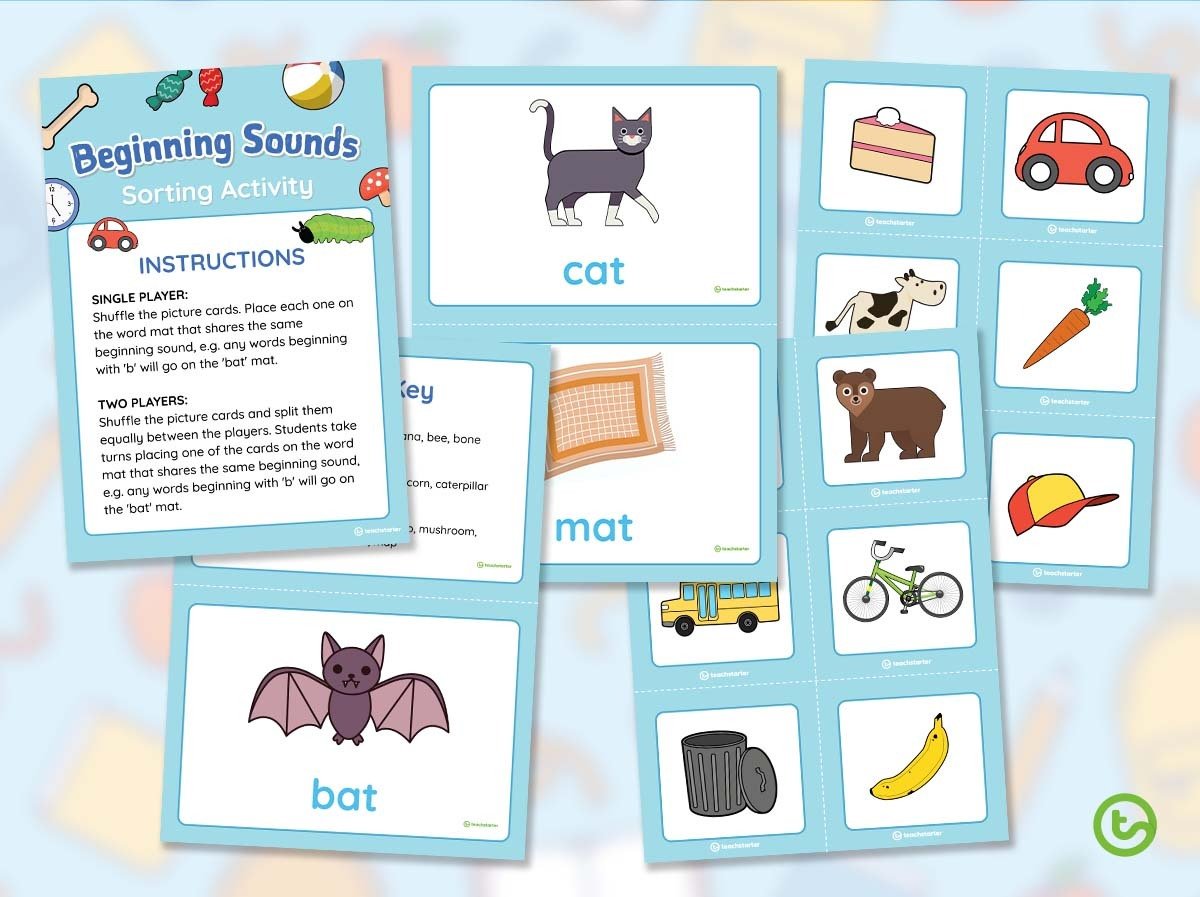When young children begin formal schooling, it can be super easy to jump straight into the learning of graphemes and phonics. The school year goes by so quickly that starting the reading and spelling journey is a teacher’s number one priority. However, a child’s phonemic awareness can often get overlooked, or a presumption made that they already have this awareness. It’s important to point out that the terms phonics and phonemic awareness are not the same. Phonemic awareness is 100% auditory and it is all about the speech sounds, whereas phonics is more about the graphemes and the letters on the page.
As you read through this blog you will notice that each activity suggested is either about a child’s listening skills and/or phoneme manipulation. Remember, phonemes are the speech sounds made in the English language.

Phonemic Awareness Listening Activities
We’ve written about the importance of explicitly teaching speaking and listening skills to children before in our blog – 10 Activities for Developing the Skills of Speaking and Listening. And, the ability to listen is also an important building block of phonemic awareness. Here are some great listening activities that you can do with your early years students at the beginning of the year to get an idea as to how well they are listening. The best part about these listening activities is they are heaps of fun and students won’t even feel like they are being tested!
Listening to Sounds
Students listen (with closed eyes) for any sounds they can hear for a few minutes. The teacher lists them. Could also make an audio recording. Try in different locations.
Sequences of Sounds
Eyes closed. The teacher makes a single sound, e.g. blowing, tapping a wall, etc. Students identify the sound. Then move to sequences of 2 sounds. They have to identify in the correct order. Move to 3 sounds that they identify in order. Repeat a sequence of sounds but warn them that one sound is going to be missing – they identify the missing sound. This is getting them ready to listen to phonemes in words and that ability to manipulate and identify each phoneme.
Where’s that Sound?
Students sit in a circle, one child is chosen to be the listener. They sit in middle with blindfolds on. Another child is chosen to go somewhere else in the room and make a noise, the listener has to describe where they are in the room and how they’re making the noise.
Multiple Instructions
Make a game of this. One student is chosen to do actions. Teacher says the complete instructions once and the student has to perform, e.g. “Hop to the door, say ‘Boo!”, then walk 3 steps back.” The rest of the class also listens to the instructions and gives thumbs up or down to judge how the student performed.
Identifying Words
Use a rhyme they know well, e.g. Hickory Dickory Dock. Focusing on the second line (the mouse ran up the clock), work out together how many words there are (6). Allocate one child to each word. This is their word. Stand these children up facing class in a line and ask each person to say their word (so the class is reading from left to right of course). Then get them to call out their words from right to left. Also, try jumbling them. Remove a word etc.
Barrier Games
Play a barrier game with your students. The players are separated by a barrier. There is a speaker and a listener. Prior to beginning the game, the speaker colored their sheet. During the game, the speaker gives precise instructions to the listener who just listens carefully and colours accordingly. The goal is for the listener to produce work which is close to being identical to that of the speaker. This can be done with activities other than colouring, too:
[resource:4501284][resource:2065190][resource:4253646][resource:4261010]
Phonemic Awareness Activities (By Skill)
To make it easier for teachers, we decided to unpack 8 of the most crucial phonemic awareness skills that young children need to master so that they can be set up for success when it comes to spelling and reading. Each of these skills outlined also includes some suggested questions and phonemic awareness activities that you could do with your students.
Phoneme Isolation and Identification
We popped these two skills together because they go hand in hand. The phoneme isolation skill is where students can identify specific phonemes in words. For example the sounds at the start of the word, the middle of the word and the end of the word. With beginning readers, these are monosyllabic words.
Here are some questions you may ask your students:
- What is the first sound in pig?
- What is the last sound in pig?
- What is the middle sound in pig?
With the phoneme identification skills, students can recognise the same sounds across multiple words, or they can identify a focus phoneme in multiple words.
Here are some questions you may ask your students for this skill:
- Which word starts with the ‘m’ sound – cat, fat, mat?
- What do these words have that are the same – mum, mat, mop?
Phoneme Isolation and Identification Activity Ideas
- Use these CVC cards (don’t use the letter cards provided). These are great as they provide a visual box for the students to point to and identify each of the sounds. You could have them pop in a counter for each of the phonemes too. For example, using the bat card, you could say – ‘What can you see?’ ‘Yes, it’s a bat!’ ‘What is the first sound in the word bat?’ ‘What is the last sound in the word bat?’ ‘What is the second sound in the word bat?’
- Use our beginning sounds sorting activity. In this activity, children need to identify the sounds that come at the start of the word. But, you could easily adapt this resource to focus on middle and end sounds too!
- Stand up, Sit Down activity. Students simply sit in their seats. As the teacher, you provide them with the focus phoneme and they must stand up when they hear that phoneme at the start of a word that you say to them – this is a very quick way to determine which students are able to identify phonemes.
Phoneme Categorisation
With the phoneme categorisation skill, students have the ability to match sounds or identify and recognise a phoneme that doesn’t belong.
You might say to a child – Which word doesn’t belong – dog, dad, rug?
Phoneme Categorisation Activity Ideas
- Using picture cards from the above-mentioned resources, this activity is perfect for a small group. Set up three baskets, you might like to put 1,2,3 on each basket to imply the ‘first’ sound, ‘second’ sound and ‘last’ sound in a word. Provide a focus phoneme such as ‘d’. Students then pick up a picture card and identify the ‘d’ sound and throw a beanbag in the correct basket. So, for the word ‘dog’ the students would throw the beanbag into the first basket. So they are identifying and sorting the picture cards based on where they can hear the ‘d’ sound.
- Simply provide three picture cards and ask the students to say what they can see. They then need to put a marker on the word that doesn’t belong.
- Turn it into an active game. Pop three hula hoops on the carpet. Tell the students you are going to say three words and they need to jump into the hula hoop of the word that doesn’t match the others. You could use visuals for this and pop a picture card into each hula hoop or you could just say the three words to the students.
Phoneme Segmentation and Blending
We have popped these two skills together because essentially you want students to be able to segment a word into its individual phonemes and then blend those phonemes together to say the word. Most of the time, I would have students practicing these skills together. Remember, this is still auditory for phonemic awareness, but you can still use picture cards and utilise multisensory activities for these skills.
You might say to a child:
- What word am I saying /m/ /a/ /t/?
- How many sounds can you hear in mat?
Phoneme Segmenting and Blending Activity Ideas
- A simple activity is using playdough and picture cards. Place a picture card in front of your students and ask them what they see – it may be a bat. Ask them, how many sounds can you hear in bat? Then have them create three playdough balls. Have them squash the balls as the segment the word /b/ /a/ /t/. Then have them roll those ‘squashed’ balls together to blend the phonemes together again.
- If you have car lovers in your class – you can do a similar thing with a car. The car stops for each sound, but keeps driving when they are blending it together.
- Turn it into an active game with some hula hoops and a strip of masking tape on the ground. Have students jump to segment the sounds in a word. Then walk across the tape when they are blending the phonemes together.

Shutterstock.com / Calvin Chan
Phoneme Deletion
Phoneme deletion is a skill that involves students manipulating spoken words by deleting specific phonemes.
You may ask your students the following:
- Say cat – now say cat without the /c/ sound.
- Say spark – now say spark without the /s/.
Phoneme Deletion Activity Ideas
- Using picture cards, hold a card and ask the students to say the word without the first sound. For example, if you are holding up a picture of a cat, the students would say ‘at’. You can then do this but with the final sound in words.
- Feed the puppet activity. Using a puppet with a mouth. Using blocks to represent the sounds in words. You could say the puppet is wanting to eat the /m/ sound today. Use the blocks and say a word that has the /m/ at the start or the end such as mat. Show the students the blocks for the sounds /m/ /a/ /t/. Which block will I feed the puppet today? Have a volunteer put the block in the puppet’s mouth and then ask what is the word now? Students would then say ‘at’.

Shutterstock.com / Rawpixel.com
Phoneme Addition
Phoneme addition involves adding a phoneme to a word to make a new word. For example, add /s/ to the beginning of the word park. What word do you have now?
Phoneme Addition Activities
- Use picture cards and hold up objects that can have phonemes added to their words. For example, hold up a picture of a pot and ask your students what is the new word if I add ‘s’ to the start of the word pot, /s/ /pot/. You can keep doing this with a variety of images.
- Use book creator to add images to a slide, record your voice saying each of the objects and then have students add a chosen phoneme to each of the words. Students can record their new words next to the old words. This also benefits the teacher as you can go back and listen and see how each student went.
Phoneme Substitution
Phoneme substitution involves the students manipulating spoken words by substituting certain phonemes for others. This has often been described as one of the hardest phonemic awareness skills as students need to complete multiple steps to get to the new word. This is why it’s often one of the last skills as students need to be able to do the phoneme addition and deletion skills first.
In this skill you may say:
- What word do we have if we change the /c/ sound to /r/ sound in cat?
- What word do we have if we change the /d/ sound to /l/ sound in dog?
Phoneme Substitution Activities
- Use plain coloured pieces of paper for this activity. First, you need three of the same coloured cards and display them so students can see (a pocket chart works well). Tap each card as students help you segment a given word – let’s say ‘hat’. Do this multiple times touching the index cards as you segment the word /h/ /a/ /t/. Now, you are going to ‘chop’ it – often a hand signal like a karate chop works well here. You will remove the first card and add a different coloured card to that same spot. This is where you give them a new sound. Let’s say /m/. Then blend those phonemes together to get the new word ‘mat’.
- Repeat above but do it with counters.
You might like to check out our Phonological Awareness Diagnostic Tool as well to get an idea of how your students are going with their overall phonemic awareness. Although this focuses on the overarching term of phonological awareness – there are many phonemic awareness tasks that would be suitable.








Comments